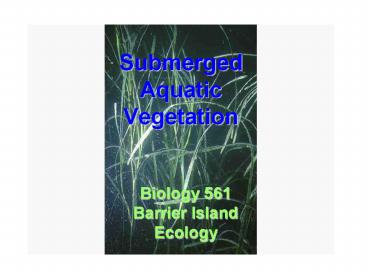Submerged Aquatic Vegetation - PowerPoint PPT Presentation
Title:
Submerged Aquatic Vegetation
Description:
Grow in shallow subtidal or intertidal water on soft muds and ... Species dependent upon seagrasses also declined (blue crabs, canvasback ducks, and others) ... – PowerPoint PPT presentation
Number of Views:202
Avg rating:3.0/5.0
Title: Submerged Aquatic Vegetation
1
Submerged Aquatic Vegetation
- Biology 561 Barrier Island Ecology
2
Submerged Aquatic Vegetation
- Typically composed of seagrasses
- Marine flowering plants
- 13 genera 58 species worldwide
- Grow in shallow subtidal or intertidal water on
soft muds and sandy sediments (some on rocky
substrates) - Evolved from terrestrial grasses
Turtle Grass, Thalassia testudinum
3
Lifestyle Requirements for Seagrasses
- Must be adapted to saline waters (true halophyte)
- Must be able to grow completely submerged
- Must be securely anchored in the substrate (some
species are anchored to rocky substrates) - Must be able to flower, fruit and produce seeds
in water - Leaves and stems lack waxy cuticle typical of
terrestrial plants - Typically possess aerenchyma tissue for bouyancy
4
Occurrence
- Worldwide in distribution
- In US, found on Atlantic, Pacific, and Gulf
coasts - 90 of seagrasses in US are in Gulf of Mexico
- Major beds in Chesapeake Bay, Florida, Texas and
California - Occur primarily in beds, typically patchy in
nature - Grasses typically found in 10-15 m of water, but
have been found down to 130 feet
5
Ecology of Seagrass Beds
- Seagrass beds are important to
- Grazersmanatees, ducks, etc.
- Epiphyte grazersfeed on seagrass
- epiphytessea urchins, fish, etc.
- Detritus feedersfeed on decaying
- organic matter
- Shelter for conch, starfish, sand
- dollars, etc
- Substrate and food for bay barnacles, sea
squirts, sponges, isopods, amphipods, snails,
seahorses, anchovies, silversides, shrimp, blue
crabs, waterfowl and others
6
Ecology of Seagrass Beds
- Bind sediments with extensive rhizomes and roots
- Baffle waves and currents
- Trap sediments/clear the water column
- Improve water quality by taking up nutrients
(epiphytes do the same) - Important in oxygenating water
- Seagrass systems protected under federal
no-net-loss policy for wetlands
7
Vulnerability of Seagrass Beds
- Conditions resulting in reduction of seagrass
beds - Nutrient loading
- Light reduction
- Physical destruction
- Rate of loss weeks to months
- Rate of recovery years
- Vegetatively slow recovery
- Seeding shows more rapid recovery
Propeller scars on seagrass beds near Windley
Key, Florida Keys
8
Common Seagrasses of the Eastern and Gulf US
Turtle Grass Thalassia testudinum
Shoal Grass Halodule wrightii
Eel Grass Zostera marina
Manatee Grass Syringodium filiforme
Widgeon Grass Ruppia maritima
Paddle Grass Halophila decipiens
9
Common US Pacific Seagrasses
Scoulers Seagrass Phyllospadix scouleri
Surfgrass Phyllospadix serrulatus
Torreys Seagrass Phyllospadix torreyi
10
Seagrass Species Distribution
- Northeast (ME-NJ)
- Zostera marina
- Ruppia maritima
- Mid-Atlantic (DE-NC)
- Halodule wrightii
- Ruppia maritima
- Southeast and Gulf (FL-Mexico, Caribbean
- Halodule wrightii
- Halophila decipiens
- Halophila engelmanii
- Halophila johnsonni
- Ruppia maritima
- Syringodium filiforme
- Thalassia testudinum
11
Seagrass Species Distribution
- West Coast of US (CA WA)
- Phyllospadix scouleri
- Phyllospadix serralatus
- Phyllospadix torreyi
- Ruppia maritima
- Zostera japonica
- Zostera marina
- Alaska
- Zostera marina
- Phyllospadix serralatus
- Hawaii
- Halophila hawaiiana
12
Causes of Decline in Seagrasses
- Dredge and fill operations
- Mooring scars
- Propeller scars
- Vessel wakes
- Jet skis
- Fish and shellfish harvesting techniques
- Sewage outfalls
- Thermal pollution
- Disease
- Storms
- Ice scour
- Epiphyte load
- Burrowing shrimp
- Green algae
13
Seagrass Diseases
- Wasting Disease of Zostera marina in the North
Atlantic Ocean - Massive die-off of Thalassia testudinum in
Florida Bay - Suspect in both cases is marine slime mold
Labyrinthula
Photomicrograph of Labyrinthula sp.
14
Seagrass Diseases
- Massive die-off of Thalassia testudinum in
Florida Bay in 1987 - Preceded by year of low freshwater runoff from
the everglades - Labyrinthula thrives in high salinity
- Restoration of Everglades freshwater flows may
help seagrasses
South Florida, Florida Bay and Keys
15
Wasting Disease
- Started in 1927 eelgrass virtually wiped out by
1933 in all of North Atlantic Ocean - Suspect factors
- Salinity extremes
- Waterfowl grazing (Brant populations plummented)
- Storms
- Increasing turbidity, eutrophication
- Slime mold, Labyrinthula
- Increased water temperatures
Eelgrass, Zostera marina
16
The Chesapeake Bay Experience
- Bay possesses 10 major species of submerged
grasses - Seagrasses serve as primary indicators of water
quality in the bay - Eel Grass, Zostera marina, had massive die-off in
1927-33 - Another major die-off of all species in the 1960s
and 1970s - Half of acreage of seagrasses disappeared
- Species dependent upon seagrasses also declined
(blue crabs, canvasback ducks, and others)
17
The Chesapeake Bay Experience
- 1960-70 decline included all species
- Suspects for decline include
- Overgrazing by animals (European Carp, cownose
carp, mute swans) - Hurricanes (Agnes, 1972)
- Warming trend
- Natural diseases (Labyrinthula)
- Point and non-point pollution
- Turbidity
- Excessive nutrients
- Herbicides
- Petrochemicals
- Dredging and boat traffic
- No one of these factors can be determined as
responsible for the general decline of seagrasses
18
The Chesapeake Bay Experience
- The most important factor in determining growth
and survival in Chesapeake Bay is the amount of
light reaching the plants - Total suspended solids
- Algae (phytoplankton)
- Epiphytes
- Nutrients/dissolved organics (color)
- Sediment in water column
19
Restoration of Seagrass Beds
- Methods of transplantation
- Plugs -- Sprig
- Cans -- Peatpot
- Direct seeding -- Seedlings
- Mats -- Boulder
- Costs estimates are 2,000/acre in 3-ft water
200,000 in 8-ft water - More emphasis on impact avoidance and
minimization rather than mitigation or
restoration






























